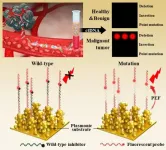(Press-News.org)
“This editorial explores its impact on expanding datasets, improving image quality, and enabling predictive oncology.”
BUFFALO, NY- September 6, 2024 – A new editorial was published in Oncotarget's Volume 15 on September 4, 2024, entitled, “Generative AI in oncological imaging: Revolutionizing cancer detection and diagnosis.”
Generative AI is revolutionizing oncological imaging, enhancing cancer detection and diagnosis. This editorial explores its impact on expanding datasets, improving image quality, and advancing predictive oncology.
In their editorial, researchers Yashbir Singh, Quincy A. Hathaway and Bradley J. Erickson from the Department of Radiology, Mayo Clinic, in Rochester, Minnesota, discuss ethical considerations and offer a unique perspective on personalized cancer screening using AI-generated digital twins.
“As we navigate this exciting frontier, we must remain committed to ethical innovation, always keeping the patient at the center of our efforts.”
Generative AI is poised to revolutionize oncological imaging, offering new hope in the fight against cancer. And while challenges remain, generative AI in oncological imaging offers unprecedented opportunities to advance cancer care and improve patient outcomes.
Continue reading: DOI: https://doi.org/10.18632/oncotarget.28640
Correspondence to: Yashbir Singh - singh.yashbir@mayo.edu
Video short: https://www.youtube.com/watch?v=W1aUwAOVqKY
Keywords: cancer, generative AI, oncological imaging, personalized cancer screening
Click here to sign up for free Altmetric alerts about this article.
About Oncotarget:
Oncotarget (a primarily oncology-focused, peer-reviewed, open access journal) aims to maximize research impact through insightful peer-review; eliminate borders between specialties by linking different fields of oncology, cancer research and biomedical sciences; and foster application of basic and clinical science.
Oncotarget is indexed and archived by PubMed/Medline, PubMed Central, Scopus, EMBASE, META (Chan Zuckerberg Initiative) (2018-2022), and Dimensions (Digital Science).
To learn more about Oncotarget, visit Oncotarget.com and connect with us on social media:
X
Facebook
YouTube
Instagram
LinkedIn
Pinterest
Spotify, and available wherever you listen to podcasts
Click here to subscribe to Oncotarget publication updates.
For media inquiries, please contact media@impactjournals.com.
Oncotarget Journal Office
6666 East Quaker St., Suite 1
Orchard Park, NY 14127
Phone: 1-800-922-0957 (option 2)
END
EMBARGOED FOR RELEASE UNTIL 11 A.M. ET FRIDAY, SEPTEMBER 6. 2024
Individuals involved in the criminal legal system have a high rate of opioid use disorder (OUD) and a high risk of overdose death compared to the general population, yet the most effective treatments—medications for opioid use disorder (MOUD)—are underutilized in criminal legal settings where treatment is mandated as part of a person’s probation or parole. Medications are often not provided due to stigma or lack of adequate funding for evidence-based care. According to a study ...
Age-related changes in the fibroblasts, cells that create the skin’s structure, contribute to the development of aggressive, treatment-resistant melanoma in males, according to research in mice by the Johns Hopkins Kimmel Cancer Center.
The study was published online Sept. 6 in Cell.
The risk of developing melanoma, a potentially deadly skin cancer, increases with age. Men are more at risk than women, and tend to develop more aggressive, hard-to-treat melanomas, particularly at advanced ages, says Ashani Weeraratna, Ph.D., the Bloomberg ...
About The Study: This population-based cross-sectional study of U.S. cancer incidence trends found that rates of diagnosis improved in 2021 but continued to be lower than expected, adding to the existing deficit of diagnosed cases from 2020. Particular attention should be directed at strategies to immediately increase cancer screenings to make up lost ground.
Corresponding Author: To contact the corresponding author, Krystle A. Lang Kuhs, PhD, MPH, email krystle.kuhs@uky.edu.
To access the embargoed study: Visit our For The Media website at this link https://media.jamanetwork.com/
(doi:10.1001/jamanetworkopen.2024.32288)
Editor’s Note: Please see ...
Scientists from Swansea University have developed a new tool to help identify optimal photovoltaic (PV) materials capable of maximising crop growth while generating solar power.
In a recent study published in Solar RRL, academics from the University’s Department of Physics have been exploring the effect of semi-transparent PV materials placed over crops – an exemplary application of agrivoltaics (solar panels combined with agricultural settings).
As part of this work, the team has developed an innovative freeware tool that predicts the light transmission, absorption, and power generation of different PV materials nearly anywhere on the globe using ...
Researchers at the Institut Pasteur in France have developed artificial “lymphoid organ-chips” that recreate much of the human immune system’s response to booster vaccines. The technology, described in an article to be published September 6 in the Journal of Experimental Medicine (JEM), could potentially be used to evaluate the likely effectiveness of new protein and mRNA-based booster vaccines for COVID-19 and other infectious diseases.
The rapid mutation and evolution of SARS-CoV-2 and other viruses ...
SAN ANTONIO -- A monoclonal antibody appears effective at neutralizing the numerous variants of SARS-CoV-2, as well as related viruses in animals that could pose a threat if they were to begin spreading in people. The antibody, called SC27, was recently described in Cell Reports Medicine.
The finding opens the possibility of broader, more effective treatments to work against current and future COVID variants.
Monoclonal antibody SC27 was identified, developed and provisionally patented by a team of researchers led ...
Every cell in our body contains the same DNA, yet liver cells are different from brain cells, and skin cells differ from muscle cells. What determines these differences? It all comes down to gene regulation; essentially how and when genes are turned on and off to meet the cell’s demands. But gene regulation is quite complex, especially because it is itself regulated by other parts of DNA.
Gene regulators: Enhancers, transcription factors
There are two important components that control gene regulation: the first are enhancers, which are short bits of DNA that increase the likelihood that a ...
Dr. Min-young Lee and Dr. Sung-gyu Park of the Advanced Bio and Healthcare Materials Research Division at KIMS have developed a technology that can detect cancer mutant genes in blood with the world's highest sensitivity of 0.000000001% based on plasmonic nanomaterials for optical signal amplification. The team tested blood samples from lung cancer patients (stages 1-4) and healthy individuals for EGFR mutations and achieved a diagnostic accuracy of 96%.
Previously utilized genetic analysis technologies had low analytical sensitivity to detect mutated genes compared to normal genes, making it difficult to accurately diagnose early-stage cancer patients. ...
COLUMBUS, Ohio – Severe drought in the American Southwest and Mexico and more severe wet years in the Northeast are the modern norm in North America, according to new research – and the analysis suggests these seasonal patterns will be more extreme in the future.
The middle of the United States, meanwhile, can expect bigger swings between wetter wet periods – high-rainfall years known as pluvials – and drier summers through the rest of this century, the study predicts.
Researchers at The Ohio State University say the findings, based on modern precipitation data, historical tree rings and climate models ...
The medical field is inherently susceptible to errors, with laboratory tests being no exception. In histopathology laboratories, where tests are considered the gold standard for diagnosing various diseases, errors can significantly impact patient outcomes. Quality Control (QC) and Quality Assurance (QA) programs are essential in minimizing these errors and ensuring the generation of accurate and reliable reports. The complex, multistep nature of histopathology work, combined with the subjective nature of many diagnostic interpretations, ...







